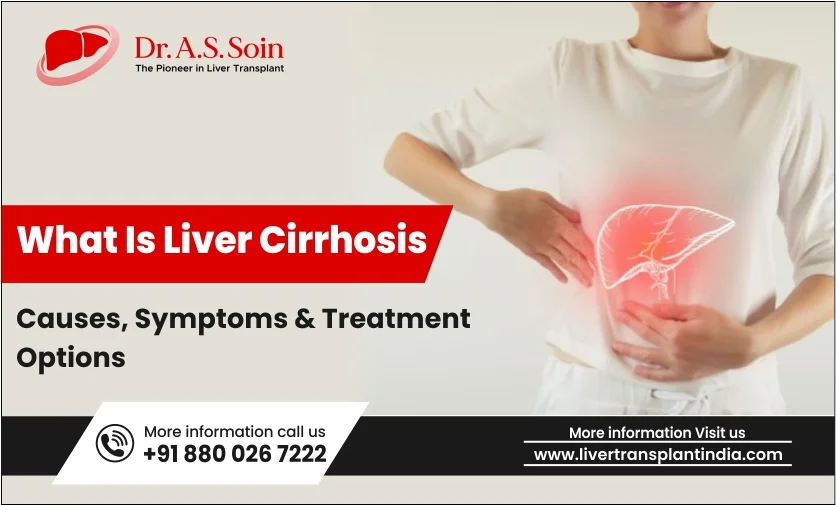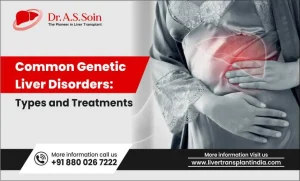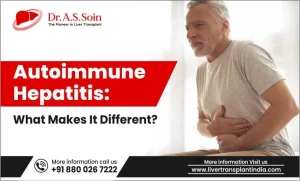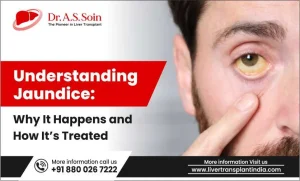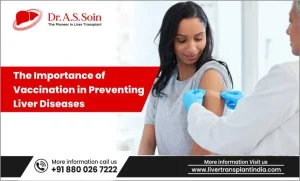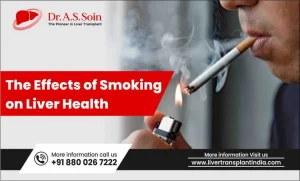Liver cirrhosis, or scarring of the liver, is a serious medical condition. Caused by chronic alcohol consumption, viral infections, injuries, and autoimmune disease, this condition can prove to be fatal without proper medical intervention.
If you are noticing yellowing of skin and eyes, fatigue, nausea and weight loss, then you must seek medical consultation from Dr. A.S. Soin, the best liver doctor in India. A national award winner for his services to liver transplantation in India, Dr. A.S. Soin and his team of surgeons and liver specialists perform over 20+ liver transplants every month on patients from India, the Middle East, and Africa.
Read further to learn about the causes of cirrhosis, symptoms, and treatment options.
Table of Contents
ToggleCauses of Liver Cirrhosis
The following is a list of common causes of liver cirrhosis-
Alcohol Consumption-
It is our liver’s function to remove the toxins from our body and produce the necessary enzymes for digesting food. Since alcohol is full of toxins, it hampers our liver’s ability to properly metabolize. Over time, excessive consumption of alcohol replaces healthy liver tissue with scar tissue (also known as cirrhosis). Cirrhosis of the liver results in inadequate synthesis of proteins and also hampers the body’s ability to filter the toxins from the blood.
Hepatitis-
Hepatitis is a medical condition which refers to the inflammation of the liver. Hepatitis is caused by a virus. Hepatitis can be transmitted via contaminated food or drink, blood transfusion, unprotected sexual intercourse, contaminated tattoo equipment, and infected needles or syringes. When left untreated this virus can lead to cirrhosis of the liver. Hepatitis A and B can be prevented with a vaccine.
Non-Alcoholic Fatty Liver Disease-
Liver cirrhosis can be caused by buildup of fat in the liver. The buildup of fat can happen because of diabetes, high blood sugar, high triglycerides, high blood pressure, and obesity. Scarring of the liver is one of the major complications of non-alcoholic fatty liver disease, also known as nonalcoholic steatohepatitis. The liver tends to get scarred due to repeated ongoing cycles of inflammation (nonalcoholic steatohepatitis) In such a case, signs of liver cirrhosis are accumulation of abdominal fluid, swelling of lower limbs, blood in vomtus/ black stools, slurred speech, and swollen abdominal veins.
Autoimmune Biliary Disease-
Primary biliary cholangitis is an autoimmune biliary disease that affects the body’s ability to produce bile because of inflammation of the bile ducts. The cause of primary biliary cholangitis is unknown. The immune system of the person with this disease becomes compromised and starts targeting the cells that line the bile duct. This attack leads to chronic inflammation and scarring of the liver which increases further by the accumulation of bile in the liver. Slowly, the healthy liver tissue is replaced with cirrhosis, and the liver can no longer function properly.
Cirrhosis Symptoms
The most common cirrhosis symptoms are-
Loss of appetite
Weight loss
Fatigue
Nausea
Intra-abdominal fluid accumulation
Visible blood vessels (veins) of the abdomen
Yellowing of skin and eyes
Mood changes
Brain fog (The spectrum varies from sleep disturbance to irrelevant behaviour to loss of conciousness)
Muscle twitching
Swelling of legs, feet, or ankles
Clubbing of the fingers
Gynecomastia (in men)
Loss of or irrergular periods (in women)
Blood in the vomiting or black stools
Liver Cirrhosis Stages
Liver specialists tend to categorize cirrhosis into two stages- compensated cirrhosis and decompensated cirrhosis. In the compensated stage, the cirrhosis is asymptomatic, as it does not show overt signs of cirrhosis. On the other hand, in the decompensated stage, cirrhosis exhibits overt complications. Liver diseases are further categorized into four liver cirrhosis stages-
Stage 1 Steatosis-
The first stage of liver cirrhosis is characterized by inflammation of the liver. Inflammation can be caused by a buildup of bile in the liver, injury to the liver, hepatitis, fatty liver, or excessive alcohol consumption. Inflammation causes the liver to expand. It is ideal for liver damage to be diagnosed in the first stage as the symptoms are curable, and with proper medical intervention, the progression of the disease can be stopped.
Stage 2 Scarring-
Inflammation is followed by liver scarring or liver fibrosis. In this stage, the healthy liver tissue starts getting replaced with scar tissue. This adversely impacts the liver’s ability to function properly. Furthermore, the scar tissue disrupts the flow of blood to the liver. At this stage, signs of liver damage tend to go unnoticed. However, with proper intervention, the liver can still recover from the damage.
Stage 3 Cirrhosis-
The third stage of liver disease is known as cirrhosis. This stage is characterized by severe liver scarring or fibrosis and noticeable symptoms of cirrhosis, like fatigue, mood swings, weight loss, loss of appetite, and weakness.
Stage 4 Liver Failure-
The final stage of liver disease is liver failure. In this stage, the liver is incapable of repairing the damage and can no longer function properly. People experience hormonal imbalance as well as buildup of harmful toxins in the body. At this stage, surgical intervention in the form of liver transplant is necessary to avoid death.
Liver Cirrhosis Treatment
Scarring or cirrhosis of the liver is permanent and cannot be undone. However, with liver cirrhosis treatment, further degradation of the liver can be slowed down and even stopped. Treatment usually depends on the stage of liver disease, the cause of liver disease, and the health of the patient. In this section, we will explore some common courses of treatment-
Hepatitis Treatment-
There are three types of viral hepatitis infections- hepatitis A, hepatitis B, and hepatitis C. People with hepatitis A and B are treated with supportive care, usually in the form of adequate fluids and nutritious foods. There is no specific medication available to treat this virus. However, doctors may prescribe vaccines for hepatitis A and B to prevent the infection. Hepatitis C is generally treated with antiviral drugs that are prescribed for 2 to 3 months with over 95% success rate. Screening for hepatitis B and C is recommended for pregnant people, people with HIV, people undergoing kidney dialysis, and people with multiple sexual partners.
Alcohol Abuse Treatment-
Excessive alcohol consumption is the leading cause of liver cirrhosis. To prevent further damage, people must stop consuming alcohol altogether. In the case of alcohol addiction, doctors may recommend a de-addiction program that involves medication and counseling.
Lifestyle Changes-
Treatment for non-alcoholic fatty liver disease involves making several lifestyle changes as it cannot be treated with medication. It is important to abstain from alcohol and cigarettes. Dr. A. S. Soni advises his patients to consume a healthy diet, exercise regularly, and achieve a healthy weight. People with non-alcoholic steatohepatitis are sometimes prescribed vitamin E supplements to prevent further cell damage.
Primary Biliary Cirrhosis Treatment-
To treat cirrhosis of the liver caused by primary biliary cirrhosis, doctors use steroid drugs and immunosuppressants to stop the immune system from targeting healthy liver cells.
Liver Transplant-
In cases of advanced liver scarring, a liver transplant is the only treatment option available. A liver transplant requires surgery where the damaged liver is replaced with a healthy liver from a deceased donor or a part of a liver from a living donor.
Portal Hypertension-
Sometimes, live cirrhosis causes the surrounding portal blood vessels to swell. To reduce portal hypertension or high blood pressure, medications are prescribed.
Conclusion
In conclusion, liver cirrhosis is an extremely serious medical condition which if not treated promptly, can get fatal. It has several underlying causes, from excessive alcohol consumption, viral hepatitis, autoimmune diseases, and metabolic syndrome. With early detection, proper medical treatment, and certain lifestyle changes. The only treatment of a decompensated liver cirrhosis is timely liver transplant which can give a new lease of life to the recipient.
If you or your family member are experiencing any of the symptoms of cirrhosis listed above, then you must book a consultation with Dr. A. S. Soni. A member of the National Advisory Board in Liver Transplantation, Dr. A. S. Soni is one of the best liver doctors with over 25+ years of experience in treating gallbladder, bile duct, and liver issues.

